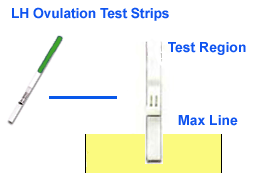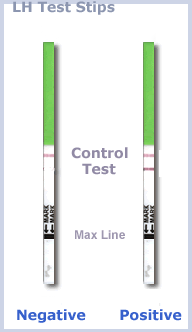Product Categories
Most popular
Product Description
Luteinizing hormone (or LH) in elevated quantities causes ovulation (the release of the egg - or ovum - from the ovarian follicle). During the menstrual cycle only a small amount of LH is made, but in the middle of the cycle LH briefly and dramatically increases. This increase is called the "LH surge" and precedes ovulation. Conception is most likely to occur within thirty-six hours following the LH surge. The LH Ovulation Test is specifically designed to detect your LH surge - the time when you are likely to ovulate. If you receive a positive on an lh test, you are in your most fertile phase of your menstrual cycle.
SPECIMEN COLLECTION AND PREPARATION
COLLECTION
Collect urine once per day, at about the same time between 10:00 A.M. and 8:00 P.M. Do not use first morning urine as a sample. Collect urine in a clean, dry cup or container.
The sample may be stored at room temperature (15º-28ºC) for up to eight hours, or in the refrigerator for up to twenty-four hours. Do not freeze the urine sample. Let refrigerated samples reach room temperature before starting the test (this will take about 30 minutes). For best results, test the urine on the same day it is collected.
TEST PROCEDURE
STEP 1: WHEN TO START TESTING: Determine the length of the menstrual cycle. The length of the menstrual cycle is the number of days from the first day of menstrual bleeding to the day before bleeding begins on the next period.
Determine the usual length of the menstrual cycle over the last few months. Then, refer to the Ovulation Calendar Cycle Chart below to determine on which day of the menstrual cycle to begin testing. If your cycle is less than twenty-one days or greater than forty days, consult a physician.
Cycle Chart
|
|
1. To begin testing, open the sealed pouch by tearing along the notch. Remove the LH test from the pouch. Note: The ideal time to test is in the afternoon, not early morning, though testing may safely take please from 10am to early evening.
 Dip end of strip into urine for 5 seconds. Do not exceed the max line.
Dip end of strip into urine for 5 seconds. Do not exceed the max line.
2. Carefully place the LH test vertically into the urine cup for 5 seconds and lay the strip flat on a clean, dry, non-absorbent surface. IMPORTANT: Do not allow the urine level to exceed the line indicated by the arrows - MAX Line (Marker Line) - near the bottom of the test dipstick, otherwise the test will not perform correctly.
3. Wait for colored bands to appear. Depending on the concentration of LH in the test specimen, positive results may be observed in as little as 40 seconds. However, to confirm negative results, the complete reaction time of 10 minutes is required.
INTERPRETATION OF RESULTS
Within three to five minutes, two color bands will appear. Do not read the results after more than ten minutes.
To determine your result, compare the color intensity, i.e. shade of color, lightness or darkness of color, of the test band to the control band. In determining a positive or negative result, it is important to compare the color intensity, for this will indicate whether or not the LH surge (indicating ovulation) is in progress.

1. Positive for the LH Surge
If the test band is of equal or greater intensity (equal or darker) than the control band, this is a positive result and a good indication that the LH surge is occurring.
2. Negative for the LH Surge
If the test band is of lesser intensity (lighter) than the control band or cannot be seen, this means the LH level of the sample is at or near its basal (normal) level and that the LH surge is not in progress.
3. Invalid Result
If no control band appears within ten minutes, the test result is invalid and should be ignored. The control band will not appear if an insufficient volume of specimen is added into the test kit. Proper procedures may not have been followed in performing the test. Repeat with a new test kit.
HOW TO RECOGNIZE THE LH SURGE
After each test, you must decide if you are having an LH surge. If your test result is positive, you are probably having an LH surge. An LH surge can last from one to three days. Ovulation is most likely to occur sometime in the day and a half following the first day of the LH surge.
If your test result is negative, you are probably not having an LH surge. Remember that a pink-rose test band lighter than the control band shows that there is only a very low level of LH in your urine. Consult our online FAQ for more information about how to apply our test results.
WHEN TO STOP TESTING
Unless otherwise specified by a doctor, stop testing once the LH surge is detected. Six to ten days of testing may be needed to detect the LH surge, though additional testing may be required. Explanations for negative results include:
1. Use of first morning urine. First morning urine should not be used for LH .
2. The concentration of LH is too low to be accurately detect.
3. Testing is performed too early or too late in the menstrual cycle (please re-read cycle chart).
4. Testing is stopped before the surge occurs, and should have been continued for a few more days.








